| Article ID | Journal | Published Year | Pages | File Type |
|---|---|---|---|---|
| 5654991 | Clinical Immunology | 2016 | 10 Pages |
â¢Gene expression data from multiple lupus mononuclear cell populations are presented.â¢Eigengenes document similarity in composition of patient and control cell fractions.â¢Data suggest altered differentiation of Tregulatory and Thelper17 cells in lupus.â¢A role for activation of the Wnt/β-catenin pathway in lupus is proposed.â¢Activation of the type I interferon pathway remains a central mechanism in SLE.
To gain novel insights into the immunopathogenesis of systemic lupus erythematosus we have analyzed gene expression data from isolated CD4+ T cells, CD8+ T cells, CD19+ B cells, and CD56+ NK-cell enriched peripheral blood cell fractions from patients and healthy donors. As predicted, type I interferon-inducible gene transcripts are overexpressed in all populations. Transcripts preferentially expressed in SLE CD4+ and CD8+ T cells include those associated with Tregulatory and Th17 effector cell programs, respectively, but in each case additional transcripts predicted to limit differentiation of those effector cells are detected. Evidence for involvement of the Wnt/β-catenin pathway was observed in both B and T cell fractions, and novel transcripts were identified in each cell population. These data point to disrupted T effector cell differentiation and the Wnt/β-catenin pathway as contributors to immune dysfunction in SLE while further supporting a central role for the type I interferon pathway in lupus.
